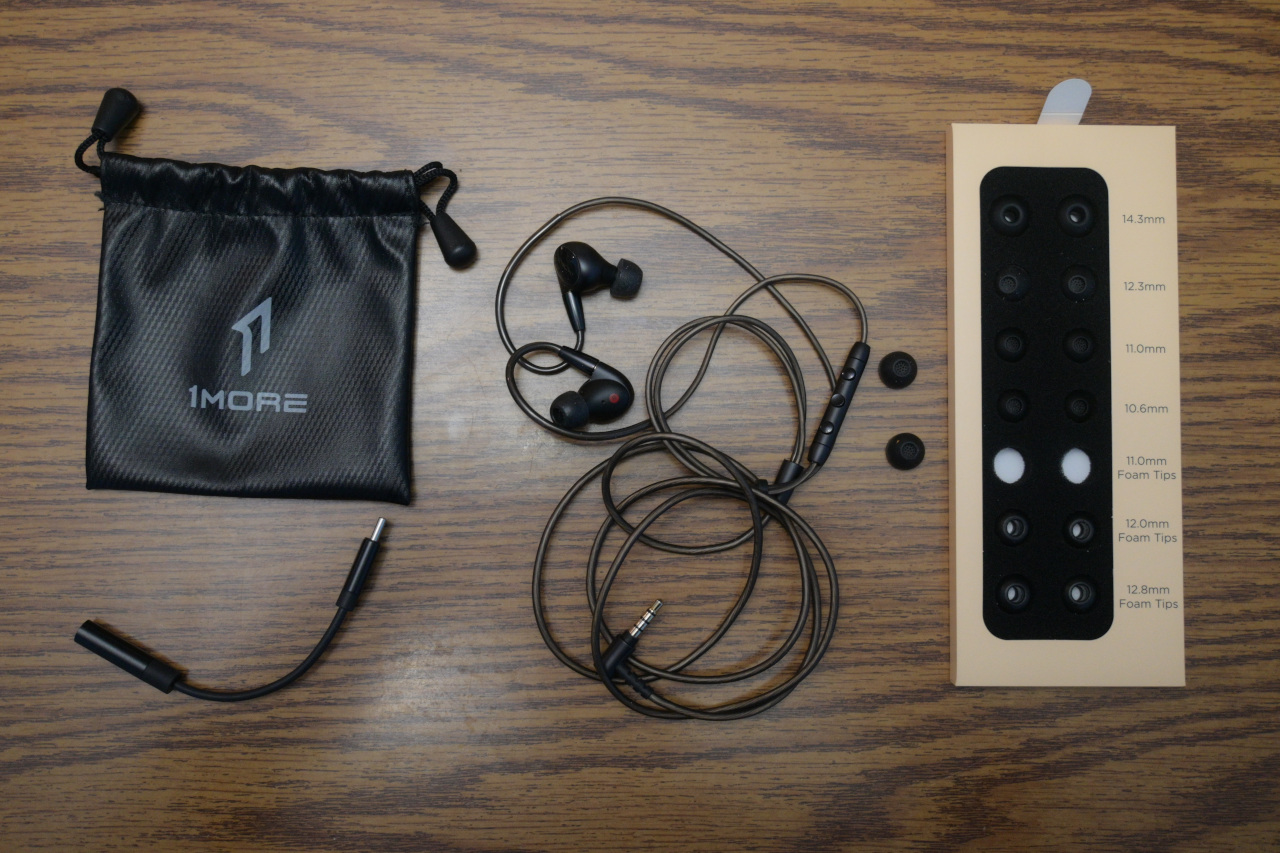Search
[{{{type}}}] {{{reason}}}
{{/data.error.root_cause}}{{{_source.title}}} {{#_source.showPrice}} {{{_source.displayPrice}}} {{/_source.showPrice}}
{{#_source.showLink}} {{/_source.showLink}} {{#_source.showDate}}{{{_source.displayDate}}}
{{/_source.showDate}}{{{_source.description}}}
{{#_source.additionalInfo}}{{#_source.additionalFields}} {{#title}} {{{label}}}: {{{title}}} {{/title}} {{/_source.additionalFields}}
{{/_source.additionalInfo}}- Details
- Category: Hardware
- By Jason Gress
- Hits: 1460
1MORE Penta Driver P50 Headphones

1MORE Penta Driver P50 Headphones
Specifications:
In-Ear Monitors
Five drivers, with one DLC (diamond-like carbon) and four planar drivers
32 Ohm impedance with 105dB sensitivity
Frequency response: 20Hz-40,000Hz
Each headphone features a MMCX connector for easy cable swaps
3.5mm to dual MMCX cable included with inline microphone, play/pause, and volume buttons, 1.25 meters long
USB-C to 3.5mm dongle DAC included
One year warranty
MSRP: $169.99
(Amazon Affiliate Link)
Thank you 1MORE for sending us the Penta Driver P50 to review!
As much as I enjoy wireless headphones for their utility and convenience, when it comes to sound quality, there really is nothing like the ol' standby, the wired headphone. While I'm happy to grab a wireless set for calls, meetings, or podcasts, when it's time to really dig in and listen to my favorite music or a brand-new album, I grab a set of wired earphones. While I do most critical listening with one of several pairs of over-ear headphones, that's not always the most practical (or possible!) environment, especially since my best pairs are open-back. So, when you want to listen privately but still enjoy that near-studio sound, in-ear monitors (IEMs) are an excellent choice.
The 1MORE Penta Driver P50 in-ear monitors are 1MORE's latest flagship wired earphone. (They used to offer an over-ear wired headphone, but sadly that's no longer the case.) Like virtually all in-ear monitors, there is a small tube with an ear tip attached, which is then inserted into the ear canal. Behind the tube is where the speaker drivers are, in a sealed cavity. The drivers are then connected to various wires, and in this case, probably a simple crossover circuit. On the bottom of the earbud is an MMCX connector, which the wires then connect to. The wires then connect to your favorite music-making device, commonly a phone, computer, Walkman, Game Boy, or even Zune - whatever you like.
Like many higher-end earphones, the P50 offers a removable cable. This is great for several reason. First, it's because the most common failure point for earphones, especially ones often in a bag or pocket, is that the wire gets damaged, rendering the earphone useless. This is so useful to me that I've actually modified several pairs of full-sized headphones to support a removable cable jack, rather than the built-in one that they came with. With a relatively tiny IEM, you can't easily fit large jacks into them, so unique standards had to be developed for such small devices. There are two main standards these days, 2-pin and MMCX. 1MORE chose the latter.
While the history isn't entirely certain, it seems that Shure popularized the MMCX connector in the mid 2000s for their IEMs, and I would say they certainly did the earphone world a favor. While the MMCX connector isn't perfect, it is generally quite sturdy and grips cables well. This P50 grips the cables almost too well; removing them is quite challenging, so much so that my first pair came apart when removing the cable. They graciously sent me a replacement, and this one has had no problems swapping cables several times. With that said, going forward I'm going to use a MMCX cable puller, which should make removing them much easier, and if you plan to swap cables a lot, I think you should, too.
Strong Points: Quite comfortable for in-ear monitors; included dongle DAC is really nice; MMCX connectors makes it easy to swap cables, including balance cables; lots of ear tip types included; sounds good with the right tips
Weak Points: Sounds terrible with the wrong tips; sound signature sounds really good for most things but not everything, with a recessed lower midrange; some may consider them price
The stock cable that comes with the P50 is in some ways really nice, and some ways less so. The connectors look and feel really well made, and aren't likely to break anytime soon. The inline mic and controls also feel good to the touch, and the buttons have a satisfying click. While the mic is nothing special, it's certainly good enough for phone calls. You could probably use it as a gaming headset in a pinch if you needed to.
The feel of the wire itself is a bit odd. It looks nice, with a dark brown color that looks sharp in contrast to the black connectors. The problem is that the wire doesn't flex easily, so it's kind of hard to untangle. Not terribly so, but most premium cables these days tend to opt for a more flexible wire design. Around the ear there is a wire that holds it to a curve, so that you can keep the earbuds from falling out and onto the ground. It works and mostly stays out of your way once inserted, though doing so is a bit tricky since the MMCX connector doesn't prevent the earbud from spinning. This means that putting them in your ears can be more of a hassle than you might otherwise expect. Thankfully, I found no functional or audio issues with the included cable. It is a bit short for some use cases, though, at about four feet. On the flipside, many people prefer shorter cables when their connected device is held in front of them or on a nearby table or in a pocket.
I also have to say that I really love that the P50 includes not only a carrying drawstring pouch, but a small dongle DAC (digital to analog converter). While I'm sure the dongle DAC is not better than larger and more expensive alternatives, it looks and feels nice, and it supports a wide range of audio bit and sample rates, with 16, 24, and 32-bit at 44.1kHz, 48kHz, 96kHz, 192kHz, and 384kHz sample rates. It also supports audio-in capture as well! This is seriously excellent, especially for what is essentially a throw-in. As for performance, it sounds fine in use, and probably a bit better than the onboard sound on my laptop. On the other hand, I wouldn't say it's better than my phone, an LG V60 with its legendary onboard Quad DAC. (LG phones were loved by audiophiles everywhere for making some of the best-sounding 3.5mm headphone jacks available on cellphones, rivaling expensive dedicated audio players.) This dongle works on Android, Windows, Linux, and probably most computers with a USB-C port. It's a really nice inclusion!
Being the crazy audiophile I am, I had to test the P50 with a balanced cable as well, and once I got the replacement P50 (the first one broke, remember?) I've used it more with a balanced cable I bought separately than without. I have used it with my Qudelix 5k, a truly fantastic mini Bluetooth DAC/AMP that I recommend for anyone who needs its extensive feature set. This is not a review of the 5k, but I thought it worth pointing out that something like this will help you get the most out of these headphones.

When I first started listening to the 1MORE Penta Driver P50, something sounded off. Out of the box, they include a silicone ear tip, like most IEMs do, and they sounded just wrong. The deepest bass was there, but the midbass was almost entirely missing, and the midrange was strangely recessed. I was concerned these were going to be a big dud. Thankfully, they sound dramatically better with the included foam ear tips. The P50's packaging includes five pairs of silicone ear tips of various sizes, and three pairs of foam tips. While the silicone tips can be comfortable, and tend to be quite durable, unfortunately only foam ones are worth using since the others just don't sound right.
With the proper tips on, they sound good. Actually, quite good. There is the occasional song that seems like it's just a bit lighter in the midbass and midrange than is desired, but it's really not a big problem. The planar drivers do an excellent job at drawing out detail, and everything sounds really clear.
When I switched to the balanced MMCX cables, the improvements were subtle but definitely there. I felt like the bass was just a bit more present, and it sounds just a bit more balanced (har har). Seriously though, at least for my listening, I just prefer how they sound when connected balanced, just a bit. To be clear, it's not like they are bad stock, they sound just a tad better with the balanced connection on my Qudelix 5k DAC/AMP. It warms the sound up just a bit, which the sound signature does need in my opinion.
Regardless, these do an excellent job grabbing that extra depth of detail. I rarely like to 'pump up the bass', but while testing, I do feel like these benefit from a gentle amount of bass boost - not a lot, and they respond wonderfully to any EQ you give them. The drivers are capable of digging extremely deep if you want them to, but the default tuning doesn't have them doing that, rather opting for a more even, neutral tuning. I'm not really a bass-head, but I was very pleasantly surprised how well these respond to a little bit (or a lot!) of EQ, if you like that.
These are also really power-efficient IEMs. While they will sound their best with a more powerful or cleaner-sounding DAC/AMP, they sound pretty good on most things I've tested. They also get plenty loud. Thankfully, they also pass what I call the '3DS test'. You see, the New Nintendo 3DS XL system has some fantastic games on it, but the headphone out on it is annoyingly quiet. I do have a small battery-powered headphone amp that I can use in a pinch to make it louder, and I have done that. But these are just efficient enough that if I didn't have that with me, I could still comfortably play games on the 3DS with these P50s. If it works well on the 3DS, it'll work well on almost anything - I promise.
The 1MORE Penta Driver P50 In-Ear Monitors are a really good set of headphones, and currently 1MORE's flagship model. They are priced that way, with a MSRP of $169.99, though thankfully are often on sale. On 1MORE's website, they are currently $119.49, a much more palatable sum. In my opinion, they are a very good pair, and sound really good. They are fairly comfortable for an IEM, and even my picky wife agreed. The shallow bump conforms to the concha perfectly, and they don't stick out too far. It also uses all smooth surfaces, so no sharp edges to get in the way or poke you. The only major source of discomfort is the same with pretty much all IEMs, and that's if you can handle having an ear tip inside your ear canal. That's not something I can answer for you. What I can say though, is that these sound truly odd with the silicone tips, so please plan to check out the foam ones. If you like foam tips on your IEMs, then I can definitely recommend the Penta Driver. If you insist on silicone ear tips, then you might be disappointed. As for me, I expect to be using these P50s the most out of my IEM collection going forward. They may not be perfect, but they're really good - and probably the best out of the IEMs I currently own.








